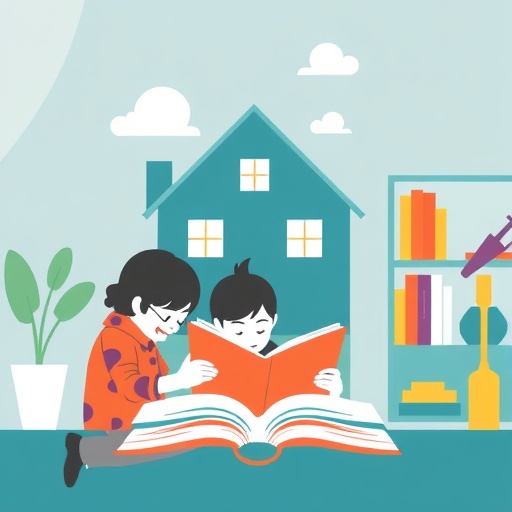In a groundbreaking study that delves into the intricate dynamics of literacy development, researchers have unveiled the profound relationship between students’ home literacy environment, their reading attitudes, and subsequent reading comprehension outcomes. This exploration, based on data from the 2021 Progress in International Reading Literacy Study (PIRLS), provides invaluable insights into the factors influencing academic success in reading during elementary education.
The authors of the study, Claes, Laga, Denies, and collaborators, meticulously analyzed data from diverse student populations to understand how various aspects of the home literacy environment contribute to shaping reading attitudes among young learners. The home literacy environment, encompassing everything from the availability of books to parental engagement in reading activities, is a crucial determinant of children’s literacy skills. The findings position home influence as a vital element in the academic trajectory of students.
Reading attitudes, defined as the dispositions individuals hold toward reading and literature, stem largely from early experiences in literacy-rich environments. The study emphasizes that positive reading attitudes significantly predict higher levels of reading comprehension. When children are encouraged to engage with literature and are provided with ample reading materials, they develop not only an affinity for reading but also the cognitive skills necessary for proficient comprehension.
The researchers adopted a serial mediation analysis approach, which allowed them to uncover the chain of relationships between the home literacy environment, reading attitudes, and comprehension skills. This methodological choice enabled them to track how influences from the home literacy environment cascade through reading attitudes to ultimately impact comprehension abilities. The results revealed that the presence of supportive and enriched literacy environments at home correlates with more favorable reading attitudes, which in turn enhances reading comprehension.
Statistical analyses highlighted that students who engage with a rich variety of reading materials and receive encouragement from caregivers demonstrate markedly superior comprehension skills compared to those with less stimulating environments. This underscores the role of familial involvement in shaping educational outcomes, reinforcing the notion that reading is not solely a school-based endeavor but a lifelong journey initiated at home.
A particularly striking element of the study is its emphasis on diversity. The researchers found that the home literacy environments varied significantly across demographic groups, influenced by socio-economic factors and cultural contexts. This variability suggests that while the effects of a supportive home environment are universally beneficial, the methods and materials employed may need to take into account the unique circumstances of each family.
Furthermore, the results emphasized the critical role of early interventions in literacy. Interventions aimed at fostering reading engagement and attitudes in the early years can lead to significant improvements in literacy skills throughout a child’s educational journey. This finding urges educators and policymakers to focus on investing resources into programs that promote literacy from early childhood.
In today’s increasingly digital landscape, the nature of the home literacy environment is evolving. With the advent of technology, children are exposed to various forms of reading material, including e-books and educational apps. The study encourages an exploration of how these digital resources factor into development, suggesting that while technology can enhance engagement, it must complement traditional literacy practices to be truly effective.
The implications of this research extend beyond academia; they embody a call to action for parents, educators, and community leaders alike. By fostering environments rich in books and supportive of reading practices, communities can lay the groundwork for improved literacy outcomes. Simple actions, like establishing family reading evenings or creating community book exchanges, can make a significant difference.
In light of these findings, the researchers propose further exploration into how specific elements of the home literacy environment can be optimized to support diverse learners. As literature continues to evolve, understanding these relationships will be crucial in ensuring that all students have equitable access to the tools they need to succeed.
In conclusion, the interplay between home literacy environments, reading attitudes, and comprehension as revealed through this comprehensive analysis offers a vital framework for understanding literacy development in children. As schools and communities rally to address literacy challenges, the insights gleaned from this study serve as a beacon of hope for shaping policies, practices, and interventions that prioritize reading in early childhood education.
The complex web of influences that drive reading comprehension underscores the necessity of a holistic approach to literacy education. By recognizing the vital role families play, and by fostering positive reading experiences, the foundation can be laid for a generation of proficient, enthusiastic readers.
This research not only enriches our understanding of literacy development but also sets the stage for future studies aimed at refining educational practices. As new data emerges and methodologies are honed, the commitment to improving literacy outcomes for all students must remain steadfast, ensuring that every child has the opportunity to discover the joys and benefits of reading.
Ultimately, the study reaffirms the idea that literacy is not just a foundational skill for academic success; it is a gateway to a world of knowledge, creativity, and connection. As the educational landscape continues to change, the importance of nurturing a love for reading from an early age has never been more crucial.
Subject of Research: The interplay between students’ home literacy environment, reading attitudes, and comprehension.
Article Title: The interplay between students’ home literacy environment, reading attitudes and comprehension: a serial mediation analysis using PIRLS 2021-data.
Article References: Claes, R., Laga, J., Denies, K. et al. The interplay between students’ home literacy environment, reading attitudes and comprehension: a serial mediation analysis using PIRLS 2021-data. Large-scale Assess Educ 12, 43 (2024). https://doi.org/10.1186/s40536-024-00233-8
Image Credits: AI Generated
DOI:
Keywords: Home literacy environment, reading attitudes, comprehension, literacy development, educational outcomes, PIRLS 2021 data.




